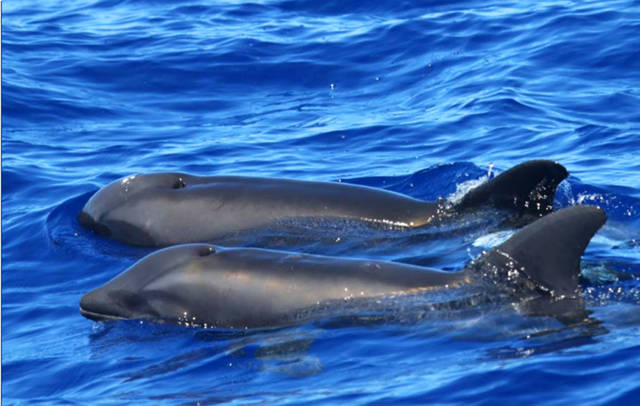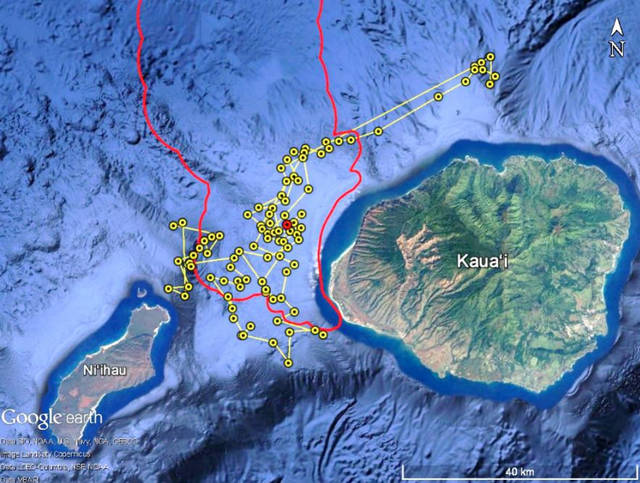Whale of a discovery


LIHUE — It looked like scientists from Cascadia Research Collective found a new species in Kauai waters in August 2017.
Now the report is out that confirms that they did, in fact, document the first-ever hybrid between a melon-headed whale and a rough-toothed dolphin during the two-week project.
Robin Baird, who headed up the project, said the discovery was their “most unusual finding”.
“We had the photos and suspected it was a hybrid from morphological characteristics intermediate between species,” Baird said. “We were able to get a biopsy sample of the animal.”
After looking into the animal’s genetics, scientists confirmed it was a hybrid they’ve named Steno bredanensis — the first ever documented rough-toothed dolphin and melon-headed whale hybrid.
The team encountered two other species rarely seen in Hawaii waters — melon-headed whales and pantropical spotted dolphins — and were able to get satellite tags on both the species, which is the second time that’s ever happened.
The first time was in 2017 and the newly released Cascadia Research Collective report contains maps that show activity based on the satellite tagging data received from the animals.
The data shows the pantropical spotted dolphins tagged spent a little time off the coast of Kauai and then oved into the deep water to the south, east and northeast of the island.
The melon-headed whales went south of Kauai and then back into the channel between Maui and Oahu.
“We don’t know a lot about how they use the area (PMRF range) yet,” Baird said.
Another first was that the Navy was able to get acoustic recordings of both the species vocalizing through the Pacific Missile Range Facility range.
“The reason is that they’re just not in the area very often and someone has to be on the water to say ‘yeah, that’s a melon-headed whale,’” Baird said.
The value to getting that acoustic information is that the Navy is able to understand how many species and what species are using the range, the frequency that they show up in the range, and what activities they do while there.
“It increases their ability to understand not only how species are using the range, but what effects Navy sonar may have on them,” Baird said.
Baird and his Cascadia Research Collective team will be back in Kauai waters for another two-week project in August, where they will be collecting photo identification, water samples and doing other research with the species in the PMRF range.
They have a list of priority species that includes beaked whales, sperm whales and false killer whales, but will also be making the most of any encounter with other species.
“We always take the same approach, we try to make the most of the opportunities as they rise,” Baird said. “During the two-week project we might encounter a false killer whale or a pilot whale once or twice, so we do a lot during those encounters.”
The coconut wireless is an immense help for the researchers while they’re here, Baird said, and they’ve collected good data on species like pilot whales because of tips from Kauai ocean users in the past.
Working with Navy personnel on the hydrophones placed throughout the underwater range, finding species themselves, and working with citizen scientists all contributes to good research.
“We’re hoping that just by talking to some tour operators and fishermen, especially folks heading across the channel to Niihau, we might get tips and encounter something like pilot whales,” Baird said.
People on the water on Kauai’s Westside should text or call Baird at 425-879-0360 if they seen any whales or dolphins other than spinner dolphins, rough-toothed dolphins or bottlenose dolphins.
“Word of mouth is tremendously valuable,” Baird said.
•••
Jessica Else, environment reporter, can be reached at 245-0452 or at jelse@thegardenisland.com.

There’s something wrong with this report.
Steno bredanensis is the scientific name of the Rough-toothed Dolphin so it can’t be given to this apparent hybrid.
The original report does not give a scientific name to the hybrid.